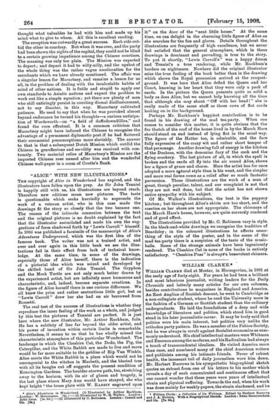"ALICE" WITH NEW ILLUSTRATIONS.* • THE copyright of Alice in
Wonderland has expired, and the illustrators have fallen upon the prey. As Sir John Tenniel is happily still with us, his illustrations are beyond reach. Therefore new editions mean new pictures. The taste is questionable which seeks hurriedly to supersede the work of a veteran artist, who in this case made the drawings fit the story so closely that the two became one. The reason of the intimate connexion between the text and the original pictures is no doubt explained by the fact that the illustrator assimilated and made his own the sug- gestions of form shadowed forth by "Lewis Carroll" himself. In 1886 was published a facsimile of the manuscript of Alice's Advengures Underground, which was the first idea of the famous book. The writer was not a trained artist, and over and over again in this little book we see the illus- trations fail in their effect from lack of technical know- ledge. At the same time, in some of the drawings, especially those of Alice herself, there is the indication of a pictorial idea which was seized and developed by the skilled band of Sir John Tenniel. The Gryphon and the Mock Turtle are not only much better drawn by the experienced artist, but are infinitely more humorous and characteristic, and, indeed, become separate creations. In the figure of Alice herself there is one curious difference. We all know the prim and rather sententious little girl, but as "Lewis Carroll" drew her she had an air borrowed from Rossetti.
The real test of the success of illustrations is whether they reproduce the inner feeling of the work as a whole, and judged by this test the pictures of Tenniel are perfect. It is just here where the new illustrator, Mr. Arthur Rackhatn, He has a subtlety of line far beyond the older artist, and his power of invention within certain limits is remarkable. Nevertheless, it seems to us that be has wholly missed the characteristic atmosphere of this particular Wonderland. The landscape in which the Cheshire Cat, the Dodo, the Pig, the Caterpillar, and the White Rabbit are made to live and move would be far more suitable to the goblins of Rip Van Winkle. Alice meets the White Rabbit in a place which would not be uncongenial to the witches in Macbeth, and the blasted tree with all its boughs cut off suggests the present condition of Kensington Gardens. The boulder-strewn path, too, stretching away to the horizon, with its air of gloom and tragedy, is the last place where Mary Ann would have strayed, she who kept bright "the brass plate with W. RABBIT engraved upon * Alice's Adventures in Wonderland. (1) Illustrated by Arthur Beckham. London : W. Heinemann. [6s. j—(2) Illustrated by W. H. Walker. London: John Lane. [Is. 6d.]—(3) Illustrated by C. Robinson. London: Cassell and Co. Lee.j
it" on the door of the "neat little house." At the same time, we can delight in the charming little figure of Alice as she searches for the fan and gloves. Details throughout the illustrations are frequently of high excellence, but we never feel satisfied that the general atmosphere, which in these drawings is dominant and pervading, is true to the story.
To put it shortly, "Lewis Carroll's " was a happy dream and Tenniel's a true rendering, while Mr. Rackham's
borders on nightmare. Nowhere did the original illustrator seize the true feeling of the book better than in the drawing which shows the Royal procession arrived at the croquet. ground. It was here that Alice defied the Queen and her Court, knowing in her heart that they were only a pack of cards. In the picture the Queen presents quite as solid a body as does Alice, but we cannot help knowing all the time that although she may shout "Off with her head!" she is really made of the same stuff as those rows of flat cards looking on in the background.
Perhaps Mr. Rackham's happiest contribution is to be found in his drawing of the mad tea-party. When one comes to consider this matter, it is quite obvious that the fur thatch of the roof of the house lived in by the March Hare should stand on end instead of lying flat in the usual way. The figure of the Hatter too, is admirable, and the face fully expressive of the crazy wit and rather short temper of that personage. Another drawing full of energy is the kitchen of the Duchess, with the demoniac fury of the cook and the flying crockery. The last picture of all, in which the spell is broken and the cards all fly into the air round Alice, shows her a figure of grace and charm. Here the artist has for once adopted a more nR.tural style than is his wont, and the simpler and more real forms come as a relief after so much fantastic perversion. These illustrations are the work of a man of great, though peculiar, talent, and our complaint is not that they are not well done, but that the artist has not shown entire sympathy with his subject.
Of Mr. Walker's illustrations, the best is the peppery kitchen; but throughout Alice's skirts are too short, and the rosettes on her shoes are not appropriate. The chimneys of the March Here's house, however, are quite correctly rendered and of good effect.
The illustrations provided by Mr. C. Robinson vary in style. In the black-and-white drawings we recognise the tradition of Beardsley ; in the coloured illustrations he affects some- thing of the style of the poster, and in the scene of the mad tea-party there is a suspicion of the taste of the music. halls. Some of the strange animals have been ingeniously rendered. The Cheshire Cat in none of the books is entirely satisfactory. "Cheshire Puss" is alwaye a benevolent chimera.




































 Previous page
Previous page